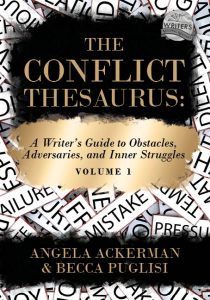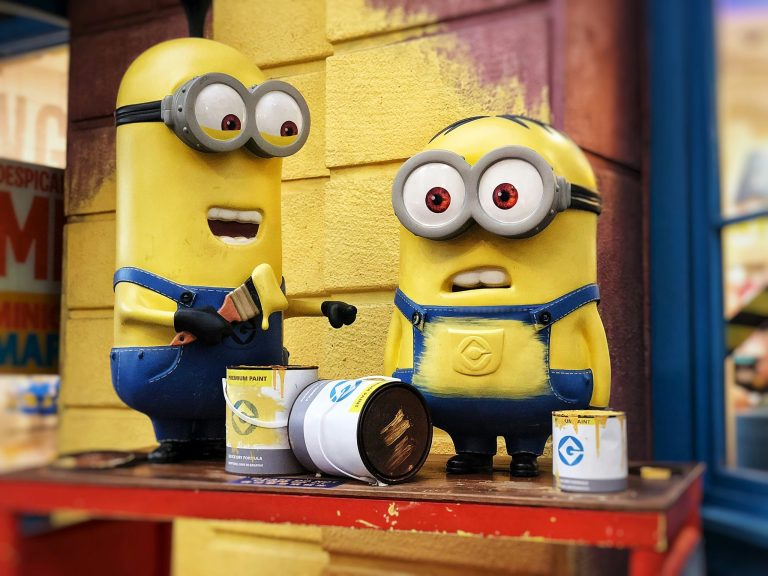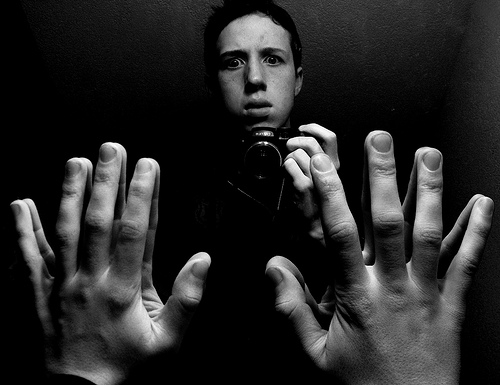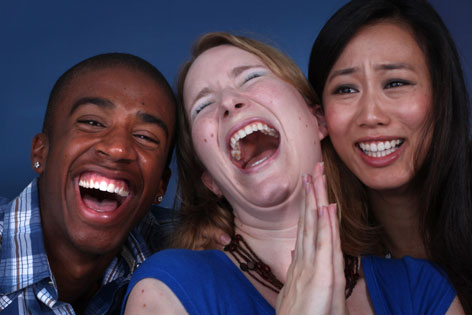How Does Internal Conflict Fit into the Character’s Arc?
Today’s guest post is by Becca Puglisi.
If you’re writing a story in which your character will need to evolve internally to achieve his goal, a cohesive and well-planned character arc will be vital to its success. This type of arc (a change arc) requires internal conflict, which will provide opportunities for your character to adapt and grow.
But first, let’s quickly summarize what the change arc is and what it looks like.
At their heart, most stories boil down to a simple formula: It’s a story about A (the character) who wants B (goal/outer motivation) because Y (inner motivation). That Y explains why the character so desperately wants to achieve the goal. If you look at the movie Groundhog Day, Phil Connors (A) wants to win Rita’s love (B) so he can find meaning in an utterly meaningless life (Y). This example shows how the character’s outer and inner motivations work together in the story.
The outer conflict is the main external thing keeping the character from his goal. Phil’s conflict comes in the form of the supernatural forces that have him reliving the same day over and over, making it virtually impossible to get Rita to fall in love with him.
But what internal conflict or struggle does Phil experience throughout the story? Or, as Michael Hauge puts it in Writing Screenplays that Sell: What is standing in the way of the character achieving real self-worth as he pursues his inner motivation? In Phil’s case, he simply loves himself too much to love anyone else. This is why his initial attempts to win Rita’s heart fail—not because of time limitations but because his motives are selfish. She sees him for the pretentious, condescending, self-absorbed prat he’s always been, so he has to resort to deception and trickery to achieve his goal. And it never works.
At his core, Phil sees himself as superior to everyone else. His inner conflict arises from the incongruence between this core perception and the truth: that every person has worth, and purpose is found not so much in being loved but in loving and serving others. His failed attempts to connect with Rita through subversive means provide internal conflict opportunities as he realizes that his ideology is flawed; until he can learn to value others and stop living solely for himself, his life will always lack meaning. Once he’s able to realign his perception with the truth and change his behavior, he finds purpose through love, and his internal conflict is resolved.
So this, in a nutshell is the change arc. It’s made up of some vital components that you’ll need to know if you’re going to map things out successfully over the course of the story: the character’s outer motivation, their inner motivation, the main outer conflict, and their inner conflict.
Figuring Out the Inner Motivation
It’s not surprising that the internal pieces are the hardest to nail down. These are subtle, and very often, they’re actively being hidden or suppressed by the character. But the inner motivation becomes obvious when you start looking for their missing human need.
Each person, and therefore each character, is unique and distinctly different. But certain elements are universal to the human experience—namely, the human needs that we require to be fulfilled.
When any of these needs are unmet, subliminal warning bells start going off. And the bigger that unmet need grows, the more motivated the character will become to fill the void. The drive to regain a missing human need will often become their inner motivation—the reason they’re pursuing the outer story goal.
As an example, Phil’s missing human need is meaning (self-actualization), something a life spent serving himself just doesn’t provide. Deep down, he’s seeking that purpose and subconsciously believes he’ll obtain it if he can find true love with Rita.
Once you know that a missing need is the key to the character’s internal motivation, that piece of the puzzle often becomes clear. Sometimes it actually helps to start your exploration of their arc with this element. If you can easily identify the void the character is desperately seeking to fill, use that information to fill in the rest of the gaps.
- What story goal might he pursue because he subconsciously believes that achieving the goal will meet his need?
- What external conflict source could realistically oppose him in the pursuit of that goal throughout the story?
- What internal conflict would get in the way?
Tips for Figuring out the Internal Conflict
And here’s where it gets tricky, because the internal stuff is harder to identify. When you’re nutting out your character’s internal conflict, think about things the character wants that put him at odds with himself—things like…
- Opposing or competing wants, needs, or desires
- Confusion about how he should feel
- Questions surrounding his core beliefs or values
- Indecision, insecurity, self-doubt, or another emotion that puts him at odds with himself
- Conflicting duties and responsibilities
- Grappling with an aspect of mental health
- A fear that keeps him from doing what he knows he should do
- A secret he thinks must be protected (maybe relating to a past wounding experience?)
These are just a few possibilities. Basically, you want to look for internal areas that are a source of struggle for the character. These are places where they’re always fighting with themselves—or places they consistently avoid or deny. Identifying those areas can help you narrow the field of possibilities for your character’s main source of internal conflict. Then it’s a matter of finding the perfect one to fit your character and their story.
Two Truths about Your Character’s Internal Conflict
It Will Directly Oppose the Inner Motivation. We see this with Phil Connors. He’s seeking connection with others as a way to gain purpose for his life, but his belief in his own superiority keeps him from being able to do that.
Whatever form the character’s internal conflict takes, it usually will block their inner motivation, denying them the one thing they desperately want or need. This conundrum will result in tons of conflict for the hero. It will also provide opportunities for the character to search his depths and eventually understand what change needs to occur so he can be free of that inner struggle.
It Will Be Tied to Self-Esteem or Fulfillment. The strongest internal conflicts are ones that touch on the most vulnerable parts of the character’s psyche: his feelings and perceptions about himself. These fundamental ideas are like the ground level of a house of cards. Poke at them and the whole thing could come crashing down.
 When Phil finds himself reliving the same day over and over, he employs the modus operandi he’s used all his life: he does exactly what he wants and doesn’t care how his actions impact others. But as one day blends interminably into the next, self-indulgence ceases to satisfy. He’s unhappy because he’s been chasing the wrong goal. Until he is able to elevate others above himself, he’ll continue to be conflicted and will never be at peace.
When Phil finds himself reliving the same day over and over, he employs the modus operandi he’s used all his life: he does exactly what he wants and doesn’t care how his actions impact others. But as one day blends interminably into the next, self-indulgence ceases to satisfy. He’s unhappy because he’s been chasing the wrong goal. Until he is able to elevate others above himself, he’ll continue to be conflicted and will never be at peace.
This is story-level internal conflict—the main wrestling match that your character will struggle with over the course of the story. If your character is traversing a change arc, you must know what their main internal conflict is so you’ll know what they need to address before the final page. The same is true if your story contains a failed arc; the only difference here is that the character will fail to embrace the change that is necessary for them to become fully realized, and their journey will end with them in the same place (or a worse one) than when they started.
Unearthing the important elements of your character’s arc can be tricky, but with a little digging, you can identify them to see how they fit together. To help, Angela and I have created a free resource that you can download from our Writing Tools page. We also explore the many forms, sources, purposes, and benefits of conflict in our newest book, The Conflict Thesaurus: A Writer’s Guide to Obstacles, Adversaries, and Inner Struggles.
 Becca Puglisi is an international speaker, writing coach, and bestselling author of The Emotion Thesaurus and other resources for writers. Her books have sold over 700,000 copies and are available in multiple languages, are sourced by US universities, and are used by novelists, screenwriters, editors, and psychologists around the world. She is passionate about learning and sharing her knowledge with others through her Writers Helping Writers blog and via One Stop For Writers—a powerhouse online resource for authors that’s home to the Character Builder and Storyteller’s Roadmap tools.
Becca Puglisi is an international speaker, writing coach, and bestselling author of The Emotion Thesaurus and other resources for writers. Her books have sold over 700,000 copies and are available in multiple languages, are sourced by US universities, and are used by novelists, screenwriters, editors, and psychologists around the world. She is passionate about learning and sharing her knowledge with others through her Writers Helping Writers blog and via One Stop For Writers—a powerhouse online resource for authors that’s home to the Character Builder and Storyteller’s Roadmap tools.
Featured Photo by jean wimmerlin on Unsplash












Wonderful post, Becca. I’ve shared it online. Thank you so much for such a concise understanding of internal conflict in characters. All best to you!
I’m so glad you enjoyed it, Victoria. I hope it answers a few questions for you.